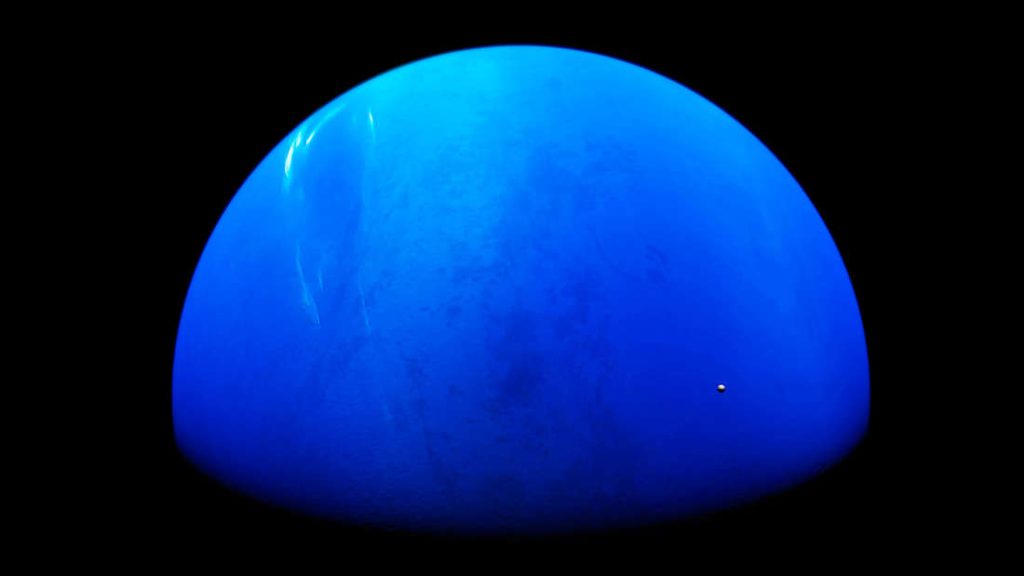
A Canadian research team has conducted nearly 3,000 simulations of our solar system. In it, they wanted to test the effects of passing stars on us and on our solar system. If the gravitational pull of a space star changes Neptune’s orbit by just 0.1 percent, it will destabilize our solar system.
Toronto (Canada) – in the universe, gravitational forces determine the interaction of planets and other celestial bodies. When a massive star flies past our solar system, its gravity can drive the farthest planet Neptune out of its orbit. Even a 0.1 percent shift in orbit can lead to this arrangement in our solar system Collapses. How likely is the scenario? And when will the solar system descend into chaos?
Small perturbations in orbit could wobble our solar system
A Canadian research team consisting of Garrett Brown and Hanno Ryan from the Department of Physical and Environmental Sciences at the University of Toronto at Scarborough and the Department of Physics at the University of Toronto conducted 2,880 simulations. They should all study the effects of the flyby of a strange orb on our solar system. Ryan also works in the Department of Astronomy and Astrophysics at the University of Toronto.
The study focused on things that were too weak to directly destabilize the planetary system. However, these objects must be powerful enough to disturb the dynamic state of our solar system. The two researchers were able to show that even small disturbances caused by stellar orbits can affect the stability of planetary systems during their lifetime – even if it doesn’t happen right away.
When does a strange celestial body cause our solar system to shake? How long will we be safe on Earth from the dangers of space?
The destabilization of Neptune’s orbit will gradually spread to other planets. However, you will not notice any of this on Earth until 20 million years later – the reason is the large distance between the planets. The Earth and Neptune The average distance between them is about 4,540 million km (4.5 billion km). The average distance between Jupiter and Earth is about 780 million km and the distance between Earth and Mars is about 230 million km.
The probability of such a scenario occurring is very low. According to scientists, it is likely that once every 100 billion years a huge space object will break its orbit. Neptune can disturb. The disturbance will not have a serious impact on our solar system as long as it is less than 0.1 percent.
Flying stars: criticism of study on potential wobble of our solar system
The researchers also showed that successive small perturbations do not have a significant effect on changing the orbits of the planets. These small disturbances are insignificant and the focus has been on larger interstellar encounters. However, they did not take into account binary stellar systems, even though half of all known stars are part of them From a binary star system be. However, the researchers hypothesize that the force of the turbulence would be two to 3.6 times stronger in a binary star system flying close to it.
The effect of Brown and Ren also has an effect on Planet 9 neglected. A large part of the international research community is convinced that another planet outside the orbits of Neptune and Pluto has not yet been found. According to the researchers, a stellar flyby would cause the largest relative change in Planet 9. However, they believe that Planet 9 would have a weak effect on the rest of the Solar System.
To study the effect of stellar flight on our solar system
The A study entitled “On the long-term stability of the solar system in the presence of weak perturbations of starburst”. (Long-Term Stability of the Solar System under Weak Disturbance from Stellar Flight) was published on 30 June 2022 in the Journal of Monthly Notices of the Royal Astronomical Society. Simulations have been limited to our solar system, although analytical estimates are general and are intended to apply to any planetary system. Future work, according to Brown and Wren, should consider the effects of the dim-flying stars exoplanet systems Investigation.

“Total coffee aficionado. Travel buff. Music ninja. Bacon nerd. Beeraholic.”








More Stories
Coral Seeding: Artificial Insemination Makes Coral More Heat Tolerant
Fear, Anger, and Denial: How People Respond to Climate Change – Research
LKH Graz: Using radiation to combat heart arrhythmias